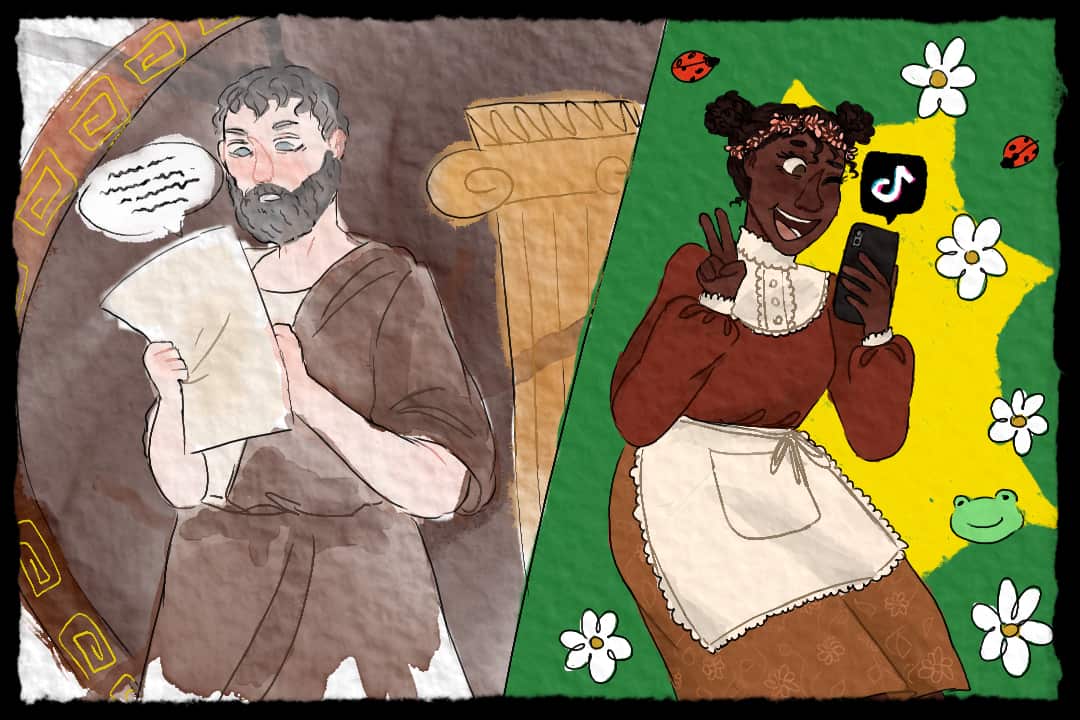Leaving campus when the sun is setting, after hours spent at a library, brings peace to my heart. The old brick, the pointed arches, and the stained glass of buildings at UTSG bestow the campus with a gothic spirit — and cast a spell upon me. I am drawn to whole worlds of inspiration. The mere sight of the shelves in Emmanuel Library galvanizes my will to learn and create. I feel my mind and eyes glowing.
The emotional experience and ambience created by these environments portray the importance and significance of aestheticism. The Greek word aisthētikos, meaning “relating to perception of the senses,” marks the origin of the modern word aesthetic. In the mid-eighteenth century, German philosopher Alexander Baumgarten coined the term ästhetisch in German — a term that has come to mean “concerned with beauty,” and which translates directly to aesthetic.
Our visual perception — of beauty or of any other quality — is important because it influences how we respond to our environment. The aesthetics of nature may inspire introspection and peace. Cities like Paris, Athens, and Prague inspire a search for beauty through art and architecture.
Today, aesthetics have come to represent more than just the appreciation of beauty. Aestheticism plays an important role on social media. Social media is all about what we are looking at. Visuals are used in very specific ways to attract varying audiences. Some people may notice their friends’ Instagram feeds following certain visual themes, from artsy to minimalist, dark to light, and everything in between.
Most viewers understand that a person’s social media presence provides a superficial or dishonest representation of reality. Regardless, social media is increasingly relevant to society — to socialization, education, the workforce, and more.
Visual perception is not only important in architecture and media, but also in how we present ourselves. Aestheticism is an online trend — dark academia, grunge, and cottagecore are all names of popular online aesthetics, and they each come with thematic visuals. For example, the cottagecore aesthetic comes with earthy colours like faded shades of green, brown, and yellow.
However, online aesthetics have come to involve more than just visuals. Personality traits and hobbies now play important roles in accurately portraying aesthetics. The dark academic mustn’t only wear tweed. Ideally, they will also be studying the humanities and often adore the works of Oscar Wilde and Emily Dickens. They carry themselves with sophistication and have Romantic values, which favour art, beauty, and imagination. Their gazes are intelligent and intense, with their eyes adorned with dark circles from staying up all night reading, writing, or studying Latin.
Dark academia is no longer only an aesthetic, but also an identity. This is the case with most aesthetics. When you see a girl wearing heavy-winged eyeliner, fishnets, and big headphones, you may assume that she also plays video games and watches anime, and conclude that she is an “e-girl.”
Of course, it is human instinct to make conclusions based on the information our senses gather — but consider what motivates our perception of others and display of ourselves.
The media’s influence on us and our behaviour is unsurprising, considering how consistently we are exposed to it. The identities designed are created within the limits of these social media platforms. As previously stated, social media’s representation of reality is superficial; therefore, so are the identities created by social media.
Aesthetically driven identities may have authentic origins. For example, cottagecore may reflect a yearning to lead a simpler life connected to nature. Aesthetics also respond to cultural and social issues. Cottagecore responds to our disconnection from the world, caused by an overwhelmingly technological society, and the toxicity of hustle culture.
Can we blame ourselves for letting our personalities be oversimplified by these identity labels? We are only coping with the reality to which we are subjected; we are only finding meaning. The search for meaning and ourselves is an inherent aspect of the human condition.
When we choose an aesthetic, we consider whether our wardrobes, friends, and ambitions match our new identities. We chip away at ourselves to simultaneously fit in and be unique. The reality, though, is that the superficiality of these identities is integral to the identities themselves, and that emptiness lies in the very pursuit of an aesthetic identity. We have to consider: without the aesthetic of our identities and without online platforms to fuel them, who are we?
In high school, I was extremely drawn to the dark academia aesthetic. I was excited to put a name to an ambience by which I had always been inspired, and a visual reflection of an ambition that is so innate in me: the ambition to learn. This fascination with dark academia manifested in me, a superficiality. Instead of reading and writing, I would just look at “aesthetic” photos of books and European architecture. I devoured this content because it easily supplemented a desire I wasn’t actively achieving.
I eventually realized that I was confusing the aesthetics of my passion with the passion for learning itself. This is the issue with online aestheticism: it offers a quick, easy alternative to actually spending time developing ourselves.
I hope that by thinking critically about these trends, people will acknowledge that ‘doing it for the aesthetic’ is a meaningless pacifier for self actualization; it is a motto convincing us that when conformity comes in variety, it provides us with more than just surrogate identities. This is a lie. Social media demands we prove our individuality to anyone who might be watching, which in turn subjects our individuality to appearances only, while our inner selves are left unattended. To deny this demand is to reclaim our right to authentic self discovery.


